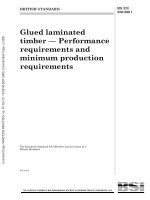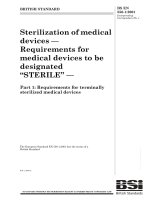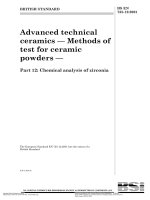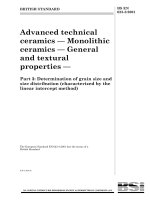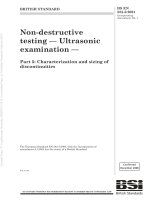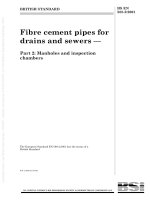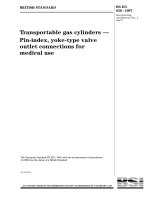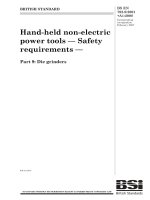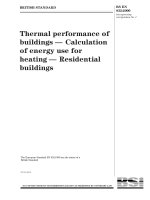Bsi bs en 00790 2001
Bạn đang xem bản rút gọn của tài liệu. Xem và tải ngay bản đầy đủ của tài liệu tại đây (603.92 KB, 12 trang )
BRITISH STANDARD
Inland navigation
vessels — Stairs with
inclination angles of
45°° to 60°° —
Requirements, types
The European Standard EN 790:2001 has the status of a
British Standard
ICS 47.020.10
NO COPYING WITHOUT BSI PERMISSION EXCEPT AS PERMITTED BY COPYRIGHT LAW
BS EN
790:2001
BS EN 790:2001
National foreword
This British Standard is the official English language version of EN 790:2001.
It supersedes BS EN 790:1995 which is withdrawn.
The UK participation in its preparation was entrusted by Technical Committee
SME/32, Ships and marine technology — Steering committee, to Subcommittee
SME/32/7, Inland navigation vessels, which has the responsibility to:
—
aid enquirers to understand the text;
—
present to the responsible European committee any enquiries on the
interpretation, or proposals for change, and keep the UK interests
informed;
—
monitor related international and European developments and
promulgate them in the UK.
A list of organizations represented on this subcommittee can be obtained on
request to its secretary.
Cross-references
The British Standards which implement international or European
publications referred to in this document may be found in the BSI Standards
Catalogue under the section entitled “International Standards Correspondence
Index”, or by using the “Find” facility of the BSI Standards Electronic
Catalogue.
A British Standard does not purport to include all the necessary provisions of
a contract. Users of British Standards are responsible for their correct
application.
Compliance with a British Standard does not of itself confer immunity
from legal obligations.
This British Standard, having
been prepared under the
direction of the Engineering
Sector Committee, was
published under the authority
of the Standards Committee
and comes into effect on
15 September 2001
Summary of pages
This document comprises a front cover, an inside front cover, the EN title page,
pages 2 to 9 and a back cover.
The BSI copyright date displayed in this document indicates when the
document was last issued.
Amendments issued since publication
Amd. No.
© BSI 08-2001
ISBN 0 580 38085 8
Date
Comments
EUROPEAN STANDARD
EN 790
NORME EUROPÉENNE
EUROPÄISCHE NORM
June 2001
ICS 47.020.10; 47.060
Supersedes EN 790:1994
English version
Inland navigation vessels - Stairs with inclination angles of 45°
to 60° - Requirements, types
Bateaux de navigation intérieure - Escaliers à angles
d'inclinaison entre 45° et 60° - Exigences, types
Fahrzeuge der Binnenschiffahrt - Treppen mit
Steigungswinkeln von 45° bis 60° - Anforderungen,
Bauarten
This European Standard was approved by CEN on 8 March 2001.
CEN members are bound to comply with the CEN/CENELEC Internal Regulations which stipulate the conditions for giving this European
Standard the status of a national standard without any alteration. Up-to-date lists and bibliographical references concerning such national
standards may be obtained on application to the Management Centre or to any CEN member.
This European Standard exists in three official versions (English, French, German). A version in any other language made by translation
under the responsibility of a CEN member into its own language and notified to the Management Centre has the same status as the official
versions.
CEN members are the national standards bodies of Austria, Belgium, Czech Republic, Denmark, Finland, France, Germany, Greece,
Iceland, Ireland, Italy, Luxembourg, Netherlands, Norway, Portugal, Spain, Sweden, Switzerland and United Kingdom.
EUROPEAN COMMITTEE FOR STANDARDIZATION
COMITÉ EUROPÉEN DE NORMALISATION
EUROPÄISCHES KOMITEE FÜR NORMUNG
Management Centre: rue de Stassart, 36
© 2001 CEN
All rights of exploitation in any form and by any means reserved
worldwide for CEN national Members.
B-1050 Brussels
Ref. No. EN 790:2001 E
Page 2
EN 790:2001
Contents
Page
Foreword .............................................................................................................................................................. 3
1
Scope ....................................................................................................................................................... 4
2
Normative references .............................................................................................................................. 4
3
Terms and definitions ............................................................................................................................. 4
4
4.1
4.2
4.3
4.4
4.5
4.6
4.7
4.8
4.9
4.10
Safety requirements ................................................................................................................................ 5
Design...................................................................................................................................................... 5
Dimensions.............................................................................................................................................. 6
Space between steps .............................................................................................................................. 8
Deviation for stairs for a height difference below 1,0 m........................................................................ 8
Landings/platforms adjacent to stairs.................................................................................................... 8
Safety of treads ....................................................................................................................................... 8
Hand rails/railings ................................................................................................................................... 8
Headroom ................................................................................................................................................ 8
Strength ................................................................................................................................................... 8
Fire resistance......................................................................................................................................... 9
5
Manufacturer's declaration ..................................................................................................................... 9
6
Designation.............................................................................................................................................. 9
Page 3
EN 790:2001
Foreword
This European Standard has been prepared by Technical Committee CEN/TC 15 "Inland navigation vessels" , the
secretariat of which is held by DIN.
This European Standard supersedes EN 790:1994.
This European Standard shall be given the status of a national standard, either by publication of an identical text or
by endorsement, at the latest by November 2001, and conflicting national standards shall be withdrawn by
November 2001.
The standard specifies requirements for stairs within the meaning of Council Directive 82/714/EEC of 4 October
1982 laying down technical requirements for inland waterway vessels.
According to the CEN/CENELEC Internal Regulations, the national standards organizations of the following
countries are bound to implement this European Standard: Austria, Belgium, Czech Republic, Denmark, Finland,
France, Germany, Greece, Iceland, Ireland, Italy, Luxembourg, Netherlands, Norway, Portugal, Spain, Sweden,
Switzerland and the United Kingdom.
www.bzfxw.com
Page 4
EN 790:2001
1
Scope
This European Standard applies to stairs with inclination angles of 45° to 60°, having at least two steps, in working
areas of inland navigation vessels.
It does not apply to stairs in passenger areas.
NOTE Whenever possible, stairs specified in EN 13056 should be preferred.
2
Normative references
This European Standard incorporates by dated or undated reference, provisions fronm other publications. These
normative references are cited at the appropriate places in the text and the publications are listed hereafter. For
dated references, subsequent amendments to or revisions of any of these publications apply to this European
Standard only when incorporated in it by amendment or revision. For undated references the latest edition of the
publication referred to applies (including amendments).
EN 711, Inland navigation vesselst – Railings for decks – Requirements, types
EN 22768-1, General tolerances – Part 1: Tolerances for linear and angular dimensions without individual tolerance
indications (Identical to ISO 2768-1:1989)
EN 13056:2000, Inland navigation vessels – Stairs with inclination angles of 30° to < 45° – Requirements, types
3
Terms and definitions
www.bzfxw.com
For the purposes of this European Standard, the following terms and definitions apply.
3.1
stair
walkway with steps solidly fixed between two planes
[EN 13056:2000, 3.1]
3.2
inclination angle
angle between the pitch line connecting the front edge of the steps and the horizontal line
[EN 13056:2000, 3.2]
3.3
stair breadth
clear breadth of the stair measured between the strings
[EN 13056:2000, 3.3]
3.4
headroom
perpendicular distance between the pitch line connecting the front edges of the steps and the fixed components
above them
3.5
step
tread of the stair
[EN 13056:2000, 3.5]
Page 5
EN 790:2001
3.6
space between steps
vertical distance between the upper edges of successive steps
[EN 13056:2000, 3.6]
3.7
depth of steps
distance between the front and rear edges of the steps measured on the tread
[EN 13056:2000, 3.7]
3.8
string
lateral limitation of the stair supporting the steps
[EN 13056:2000, 3.8]
3.9
railing
construction of stanchions, hand rail and intermediate rails or network
[EN 13056:2000, 3.9]
3.10
height of railing
perpendicular distance between the pitch line connecting the front edges of the steps and the upper edge of the
hand rail
3.11
hand rail
www.bzfxw.com
3.11.1
upper continuous part of a railing running in parallel to the string and serving as a handhold to persons using the
stair and protecting them from falling outboard of the railing
[EN 13056:2000, 3.11.1]
3.11.2
round secton which is fixed at a bulkhead adjacent to the stair, running in parallel to the stairway and serving as a
handhold
[EN 13056:2000, 3.11.2]
3.12
stanchion
part of the railing connecting hand rail and intermediate rail, if any, to the string
[EN 13056:2000, 3.12]
3.13
intermediate rail
continuous part fixed between hand rail and string serving as additional protection from falling outboard of the railing
4
4.1
Safety requirements
Design
For stairs, the dimensions and specifications given in 4.2 to 6 shall be met; the design style does not have to
correspond to figure 1.
Page 6
EN 790:2001
4.2
Dimensions
General tolerances: ISO 2768 - c conforming to EN 22768-1
Stairs, railings, platforms as well as free space in front of and above the stairs shall conform to to specifications given
in tables 1 and 2.
Table 1 — Stair dimensions and their explanation
Dimensions in millimetres
Symbol
Explanation
Dimensions
α
A
Inclination angle of the stair
Space between steps
B
C
Depth of steps
Vertical distance between the upper edge of the lowest step and the floor
E
f1
f2
G
h
Vertical distance between the upper rear edge of the highest step and the front
edge of the upper landing
Stair breadth between the strings
Clear width between railings or hand rails
Distance between hand rail and fixed components
Height of railing
900 +500
i
j
k
n
Vertical distance between the centre lines of hand rail and intermediate rail
Distance between stanchions, measured at the hand rail
Headroom
Number of steps
≈ h/2
≤ 1 500
≥ 2 100
–
see table 2
see table 2, 4.3
and 4.4
see table 2
a +−10
30
≤ 30
≥ 600
≥ 600
≥ 60
www.bzfxw.com
Tabee 2 — Dimensions α, a und b
Dimensions in millimetres
Dimensions
αa)
a b)
Stairs for outside area and general use
45°
200 +300
50°
20
200 +−10
55°
200
Stairs for machine and boiler
rooms
60°
0
200 −30
b
≥ 230
≥ 200
≥ 175
≥ 150
) Intermediate values of α are permissible, the associated values of a and b are to be interpolated.
b
) see 4.4
a
Page 7
EN 790:2001
Stair with 45° inclination angle is illustrated
Dimensions in millimetres
www.bzfxw.com
Legend
1 Step on upper landing
2 Step one step spacing a lower than upper landing
Figure 1 — Illustration of stair with 45°° inclination angle
Page 8
EN 790:2001
4.3
Space between steps
The selected space between steps a shall be kept for all steps of a stair.
The value of a for two successive steps shall not differ by more than ± 2 mm.
The uppermost step of a stair shall be at the same horizontal level as the adjacent landing or shall end one normal
step underneath, see figure 1, variation 2.
In compensation, the vertical distance between the upper edge of the lowest step and the floor, dimension c, may
differ from the selected space between steps a by + 10 mm.
Steps shall be fixed in the horizontal plane.
4.4
Deviation for stairs for a height difference below 1,0 m
As a deviation from the information given in table 1, the space between steps can be a = 230 +−40
30 for stairs with a
height difference below 1,0 m.
4.5
Landings/platforms adjacent to stairs
In front of stairs, there shall be a tread of at least 800 mm depth and at least the same width as the stair.
Platforms adjacent to stairs shall have railings as specified in EN 711 at the sides of the area used as a walkway.
Coamings shall be scalloped at platforms or adjacent landings in the walkway up to the height of the adjacent step.
4.6
Safety of treads
www.bzfxw.com
Steps and platforms shall have a non-slip surface. They shall be designed in such a way that they can be easily
cleaned and that water cannot accumulate. The front edge of steps shall be designed so that slipping and stumbling
will be prevented.
4.7
Hand rails/railings
Stairs with up to three steps shall have a handhold at one side instead of a railing.
Stairs with more than three steps shall be provided with railings or hand rails at both sides.
Railings of stairs with an inclination angle α up to 55° shall have an intermediate rail at half the railing height.
Hand rails or railings shall be continuous over the full length of the stairway At their upper ends they shall be suitably
connected to structures or other continuous railings. At their lower ends hand rails and railings shall extend to the
vertical above the outermost point of the string.
Hand rails shall be designed in such a way that their connectors do not hinder the continuous movement of the hands.
Their distance g from adjacent structures shall be at least 60 mm; their ends shall be arranged to prevent injuries and
to avoid damage to clothes.
4.8
Headroom
The headroom k shall be at least 2100 mm.
4.9
Strength
Stairs shall be permanently installed.
Steps shall be designed for a single load of at least 1,5 kN. If the expected load of 5 kN/m2 leads to greater values,
these shall be the basis for calculation.
Page 9
EN 790:2001
The fixed stairs shall withstand a load which corresponds to 50 % of the total of the step loads without producing
permanent deformation.
2
For treads and platforms adjacent to stairs, a load (imposed load) of 5 kN/m shall be assumed.
Hand rails and intermediate rails shall be capable of withstanding a load of 500 N at any point without permanent
deformation and shall not be deflected more than 20 mm.
4.10 Fire resistance
Stairs shall be made of non-combustible material, e.g. steel.
5
Manufacturer's declaration
The manufacturer has to declare that the stair is constructed conforming to this standard.
6
Designation
Stairs shall be designated in accordance with the following details:
a)
Description "Stair"
b)
Standard main number "EN 790"
c)
Inclination angle α, in degrees
d)
Stair breadth f1, in millimetres
e)
Number of steps n
f)
Space between steps a, in millimetres
EXAMPLE:
Stair EN 790 – 45 – 1 000 – 12 – 200
BS EN 790:2001
BSI — British Standards Institution
BSI is the independent national body responsible for preparing
British Standards. It presents the UK view on standards in Europe and at the
international level. It is incorporated by Royal Charter.
Revisions
British Standards are updated by amendment or revision. Users of
British Standards should make sure that they possess the latest amendments or
editions.
It is the constant aim of BSI to improve the quality of our products and services.
We would be grateful if anyone finding an inaccuracy or ambiguity while using
this British Standard would inform the Secretary of the technical committee
responsible, the identity of which can be found on the inside front cover.
Tel: 020 8996 9000. Fax: 020 8996 7400.
BSI offers members an individual updating service called PLUS which ensures
that subscribers automatically receive the latest editions of standards.
Buying standards
Orders for all BSI, international and foreign standards publications should be
addressed to Customer Services. Tel: 020 8996 9001. Fax: 020 8996 7001.
Standards are also available from the BSI website at .
In response to orders for international standards, it is BSI policy to supply the
BSI implementation of those that have been published as British Standards,
unless otherwise requested.
Information on standards
BSI provides a wide range of information on national, European and
international standards through its Library and its Technical Help to Exporters
Service. Various BSI electronic information services are also available which give
details on all its products and services. Contact the Information Centre.
Tel: 020 8996 7111. Fax: 020 8996 7048.
Subscribing members of BSI are kept up to date with standards developments
and receive substantial discounts on the purchase price of standards. For details
of these and other benefits contact Membership Administration.
Tel: 020 8996 7002. Fax: 020 8996 7001. Further information about BSI is
available on the BSI website at .
Copyright
Copyright subsists in all BSI publications. BSI also holds the copyright, in the
UK, of the publications of the international standardization bodies. Except as
permitted under the Copyright, Designs and Patents Act 1988 no extract may be
reproduced, stored in a retrieval system or transmitted in any form or by any
means – electronic, photocopying, recording or otherwise – without prior written
permission from BSI.
This does not preclude the free use, in the course of implementing the standard,
of necessary details such as symbols, and size, type or grade designations. If these
details are to be used for any other purpose than implementation then the prior
written permission of BSI must be obtained.
BSI
389 Chiswick High Road
London
W4 4AL
If permission is granted, the terms may include royalty payments or a licensing
agreement. Details and advice can be obtained from the Copyright Manager.
Tel: 020 8996 7070.

